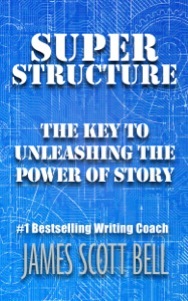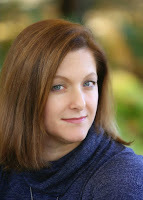One Writing Book Every Writer Needs, Super Structure
by Lynn Blackburn @LynnHBlackburn
 Every time I see a book on “structure” or “story” I find myself bracing for the inevitable battle. If you’ve hung around with writers for long you know why, don’t you?
Every time I see a book on “structure” or “story” I find myself bracing for the inevitable battle. If you’ve hung around with writers for long you know why, don’t you?
Someone is about to get in an argument about THE way to write. In my mind, I see a group of literary protesters. “Structure Leads to Perfect Stories!” shouts one side. “Structure Leads to Predictable Stories!” counters the other.
I see myself standing in the middle of the crowd singing, “LET IT GO!”
Don’t get me wrong. If someone has figured out how they write, I want them to tell me how they do it. I really do.But I have absolutely no illusions that the way they do it is going to wind up being the way I do it. I wish it would work that way but I know a lot of writers, and I have yet to meet one who writes exactly like someone else.
I’m okay with that. It’s part of the mystery of story…and I love a good mystery.
 When I pick up a book on the craft, I’m not searching for the holy grail of literary longevity. I’ve given up on finding a book that I can follow step by step onto the New York Times Bestsellers list.
When I pick up a book on the craft, I’m not searching for the holy grail of literary longevity. I’ve given up on finding a book that I can follow step by step onto the New York Times Bestsellers list.
I’m just looking for a few tips that I can implement in my own hodgepodge way of uncovering the story that’s trying to be told through me.
Super Structure by James Scott Bell had more than a few gems. Even if you’ve read every book he’s written on the craft (as I have) you’ll still find some new information and new ways of looking at things that will be useful as you craft your story. And it really doesn’t matter whether you consider yourself a plotter, an organic writer (my preferred term for “pantsers”), or if you fall somewhere in between (“plantser?”). I think this book would be well worth your time.
With a title like Super Structure , you might expect a book that expounds on the necessity of an outline.
But that’s not what Super Structure is.
Sure, he spends the first 15% of the book arguing for his preferred method (he says at one point that it’s starting to sound like a legal brief). If you’re a plotter you’ll be eating it up, but if you write more organically don’t let it get you down.
The 14 Signposts that he says make up the super structure of all good stories are important to know, no matter how you choose to implement them.
Here they are:
Act I (no greater than 20% of your novel) 1. Disturbance 2. Care Package 3. Argument against Transformation 4. Trouble Brewing 5. Doorway of No Return #1
Act II (that large middle portion where the main action takes place) 6. Kick in the Shins 7. The Mirror Moment 8. Pet the Dog 9. Doorway of No Return #2
Act III (the resolution) 10. Mounting Forces 11. Lights Out 12. Q Factor 13. Final Battle 14. Transformation
In typical James Scott Bell fashion, each point is explained in a very conversational style with multiple examples from movies and literature. He concludes each section with a “Why This Works” explanation and then “Helpful Hints for Plotters and Pantsers” where he gives ideas for how to use each signpost regardless of how you prefer to write.
I’ll be thinking about these signposts and referring to Super Structure often as I discover what my story is about it, and as I continue to figure out what method of writing works best for me.
So how about you? Are you a plotter? Do you write organically? Have you tried to write one way and failed? Tell us about it in the comments!
Don’t forget to join the conversation!
TWEETABLEOne #writing book every writer needs, Super Structure by @JamesScottBell, via @LynnHBlackburn (Click to Tweet)
 Lynn Huggins Blackburn believes in the power of stories, especially those that remind us that true love exists, a gift from the Truest Love. She’s passionate about CrossFit, coffee, and chocolate (don’t make her choose) and experimenting with recipes that feed both body and soul. She lives in South Carolina with her true love, Brian, and their three children. You can follow her real life happily ever after at http://www.lynnhugginsblackburn.com.
Lynn Huggins Blackburn believes in the power of stories, especially those that remind us that true love exists, a gift from the Truest Love. She’s passionate about CrossFit, coffee, and chocolate (don’t make her choose) and experimenting with recipes that feed both body and soul. She lives in South Carolina with her true love, Brian, and their three children. You can follow her real life happily ever after at http://www.lynnhugginsblackburn.com.
 Every time I see a book on “structure” or “story” I find myself bracing for the inevitable battle. If you’ve hung around with writers for long you know why, don’t you?
Every time I see a book on “structure” or “story” I find myself bracing for the inevitable battle. If you’ve hung around with writers for long you know why, don’t you? Someone is about to get in an argument about THE way to write. In my mind, I see a group of literary protesters. “Structure Leads to Perfect Stories!” shouts one side. “Structure Leads to Predictable Stories!” counters the other.
I see myself standing in the middle of the crowd singing, “LET IT GO!”
Don’t get me wrong. If someone has figured out how they write, I want them to tell me how they do it. I really do.But I have absolutely no illusions that the way they do it is going to wind up being the way I do it. I wish it would work that way but I know a lot of writers, and I have yet to meet one who writes exactly like someone else.
I’m okay with that. It’s part of the mystery of story…and I love a good mystery.
 When I pick up a book on the craft, I’m not searching for the holy grail of literary longevity. I’ve given up on finding a book that I can follow step by step onto the New York Times Bestsellers list.
When I pick up a book on the craft, I’m not searching for the holy grail of literary longevity. I’ve given up on finding a book that I can follow step by step onto the New York Times Bestsellers list.I’m just looking for a few tips that I can implement in my own hodgepodge way of uncovering the story that’s trying to be told through me.
Super Structure by James Scott Bell had more than a few gems. Even if you’ve read every book he’s written on the craft (as I have) you’ll still find some new information and new ways of looking at things that will be useful as you craft your story. And it really doesn’t matter whether you consider yourself a plotter, an organic writer (my preferred term for “pantsers”), or if you fall somewhere in between (“plantser?”). I think this book would be well worth your time.
With a title like Super Structure , you might expect a book that expounds on the necessity of an outline.
But that’s not what Super Structure is.
Sure, he spends the first 15% of the book arguing for his preferred method (he says at one point that it’s starting to sound like a legal brief). If you’re a plotter you’ll be eating it up, but if you write more organically don’t let it get you down.
The 14 Signposts that he says make up the super structure of all good stories are important to know, no matter how you choose to implement them.
Here they are:
Act I (no greater than 20% of your novel) 1. Disturbance 2. Care Package 3. Argument against Transformation 4. Trouble Brewing 5. Doorway of No Return #1
Act II (that large middle portion where the main action takes place) 6. Kick in the Shins 7. The Mirror Moment 8. Pet the Dog 9. Doorway of No Return #2
Act III (the resolution) 10. Mounting Forces 11. Lights Out 12. Q Factor 13. Final Battle 14. Transformation
In typical James Scott Bell fashion, each point is explained in a very conversational style with multiple examples from movies and literature. He concludes each section with a “Why This Works” explanation and then “Helpful Hints for Plotters and Pantsers” where he gives ideas for how to use each signpost regardless of how you prefer to write.
I’ll be thinking about these signposts and referring to Super Structure often as I discover what my story is about it, and as I continue to figure out what method of writing works best for me.
So how about you? Are you a plotter? Do you write organically? Have you tried to write one way and failed? Tell us about it in the comments!
Don’t forget to join the conversation!
TWEETABLEOne #writing book every writer needs, Super Structure by @JamesScottBell, via @LynnHBlackburn (Click to Tweet)
 Lynn Huggins Blackburn believes in the power of stories, especially those that remind us that true love exists, a gift from the Truest Love. She’s passionate about CrossFit, coffee, and chocolate (don’t make her choose) and experimenting with recipes that feed both body and soul. She lives in South Carolina with her true love, Brian, and their three children. You can follow her real life happily ever after at http://www.lynnhugginsblackburn.com.
Lynn Huggins Blackburn believes in the power of stories, especially those that remind us that true love exists, a gift from the Truest Love. She’s passionate about CrossFit, coffee, and chocolate (don’t make her choose) and experimenting with recipes that feed both body and soul. She lives in South Carolina with her true love, Brian, and their three children. You can follow her real life happily ever after at http://www.lynnhugginsblackburn.com.
Published on July 02, 2015 01:00
No comments have been added yet.



